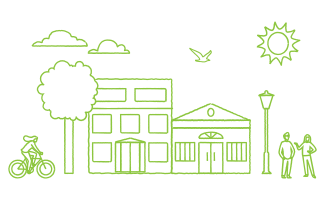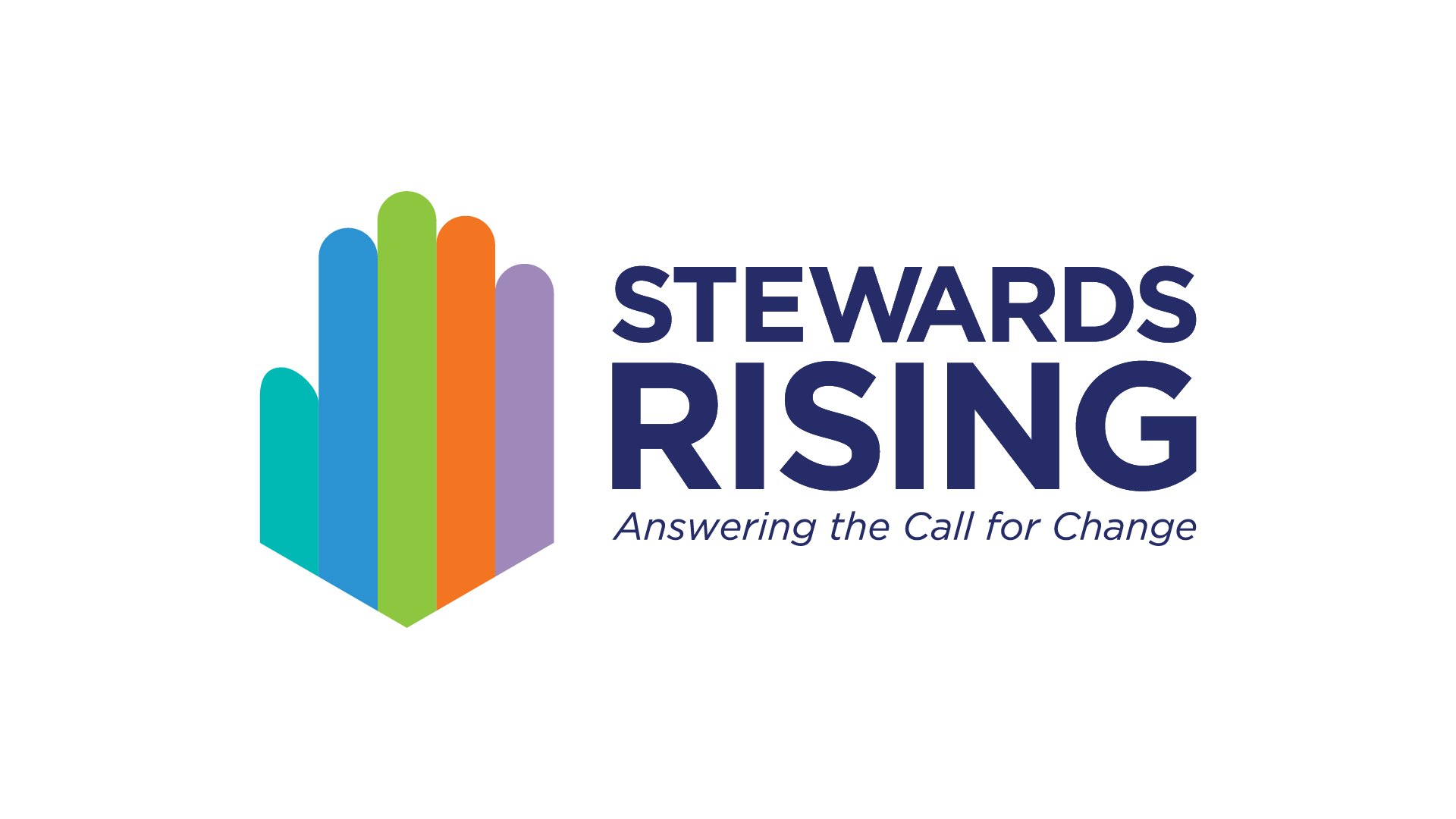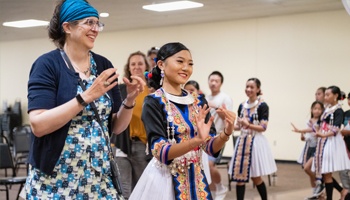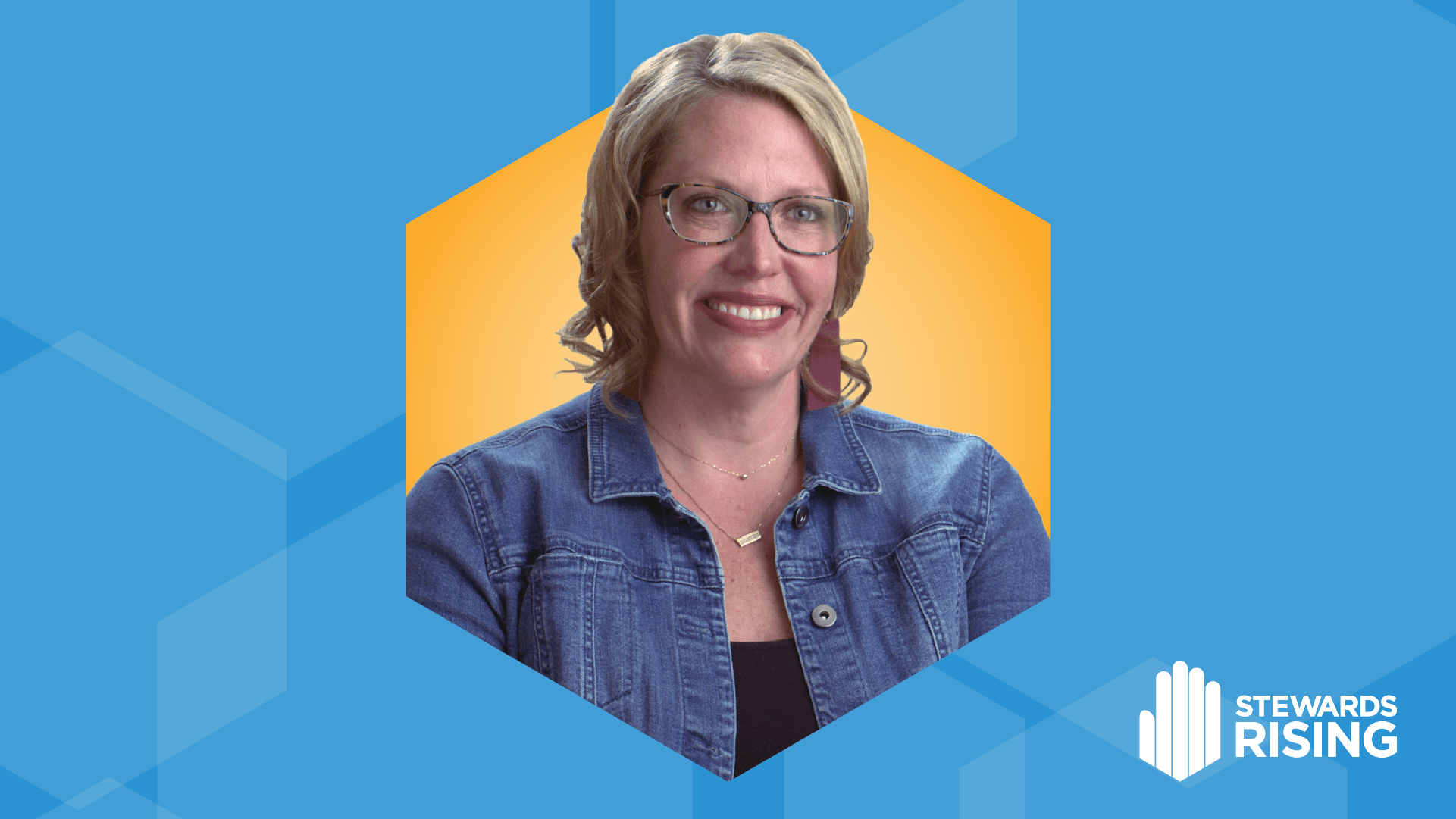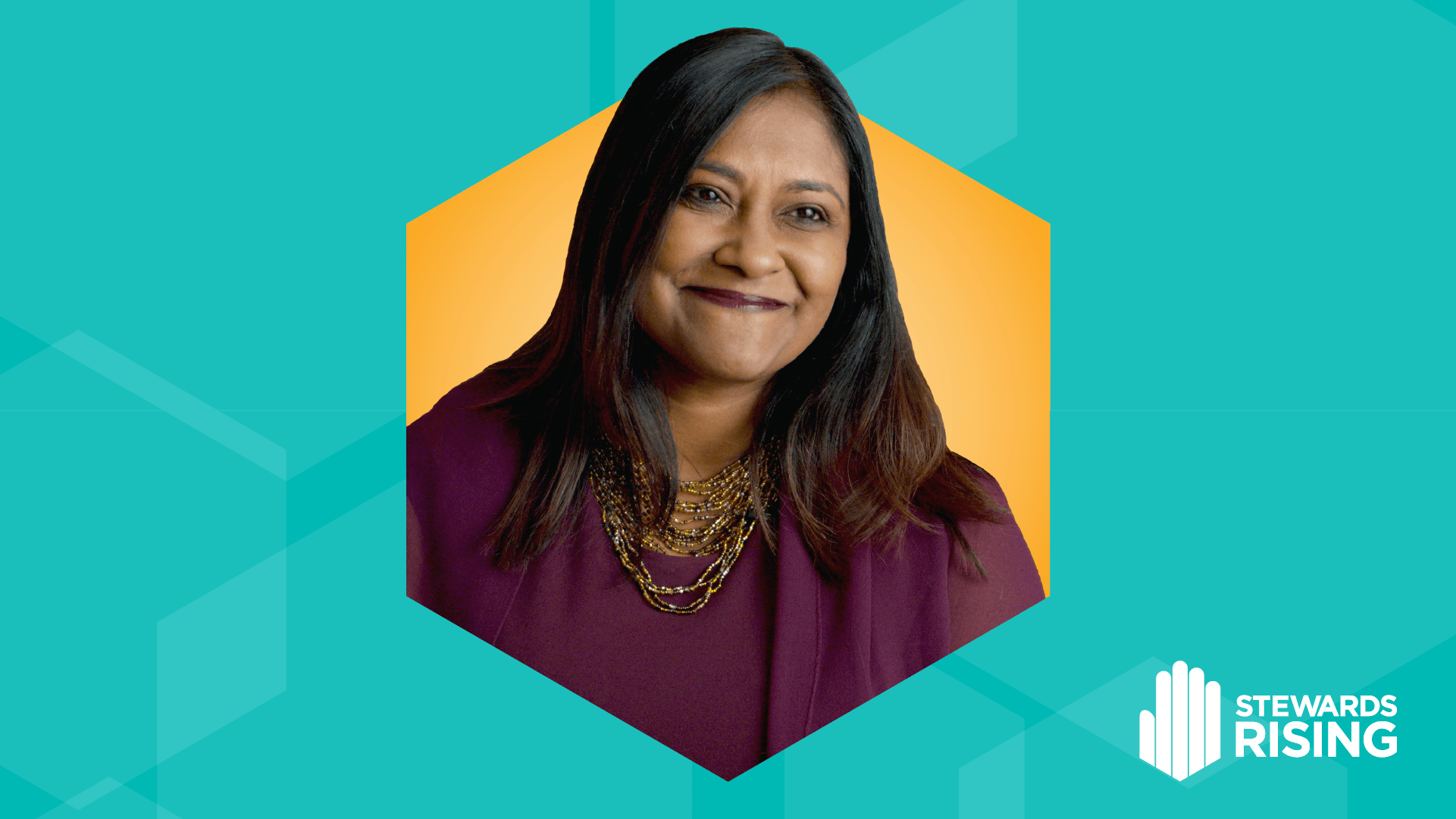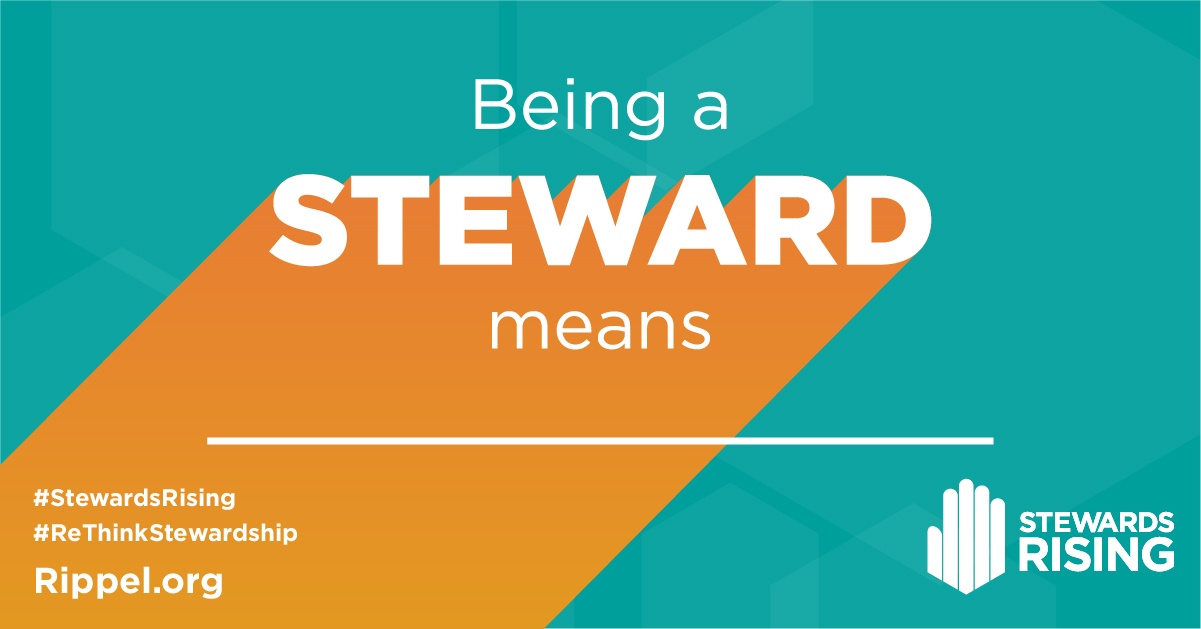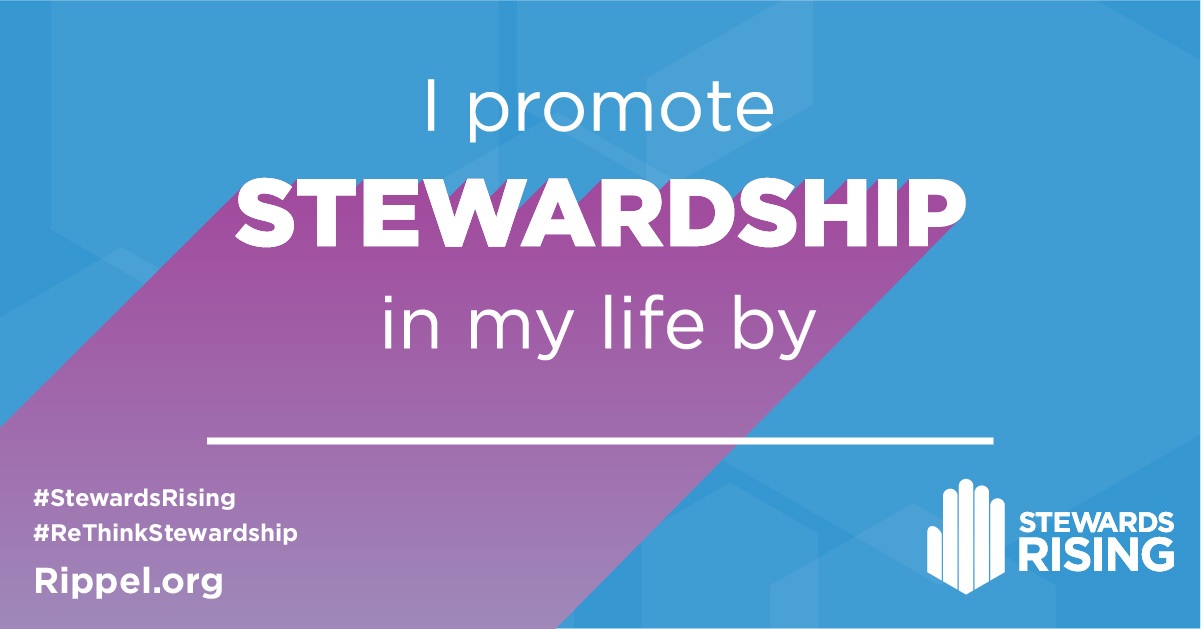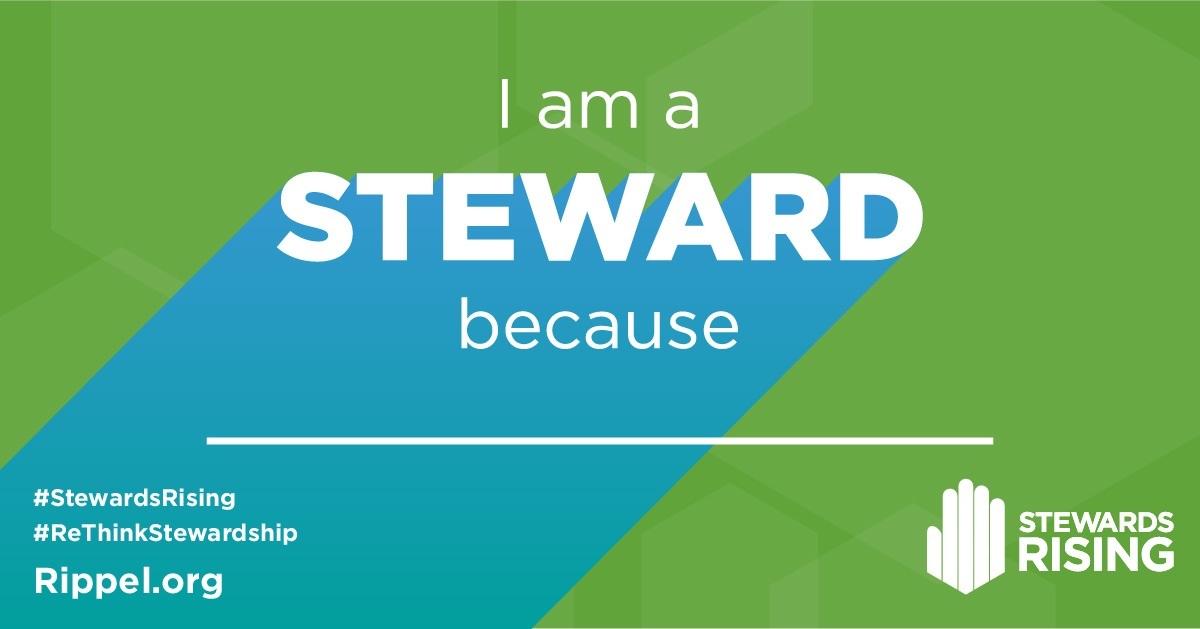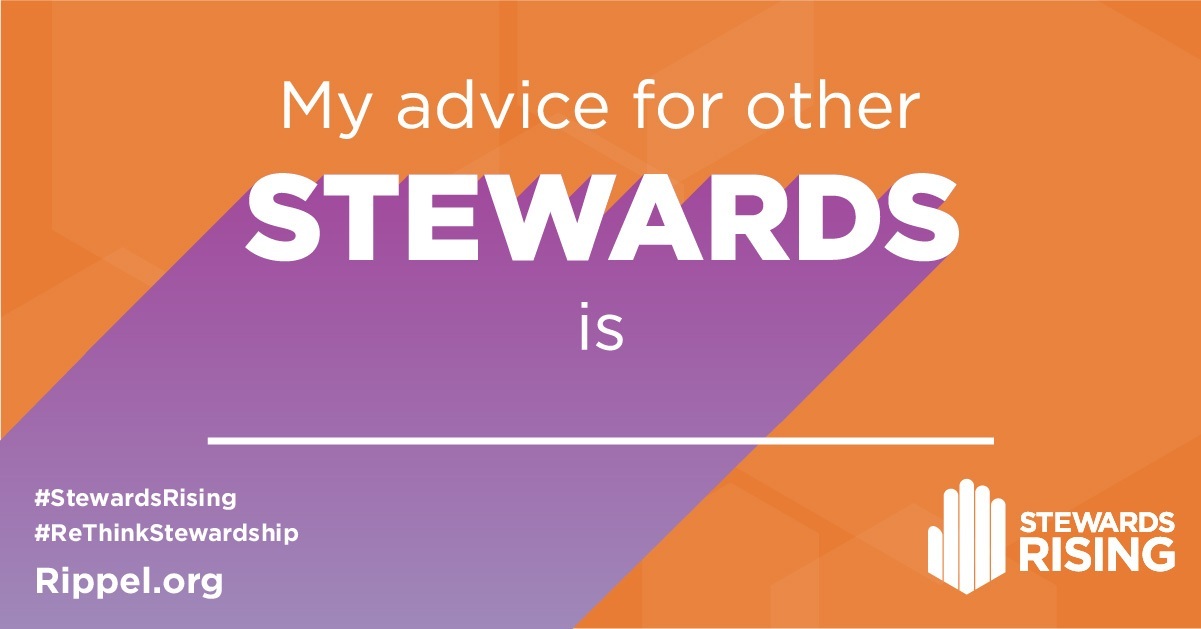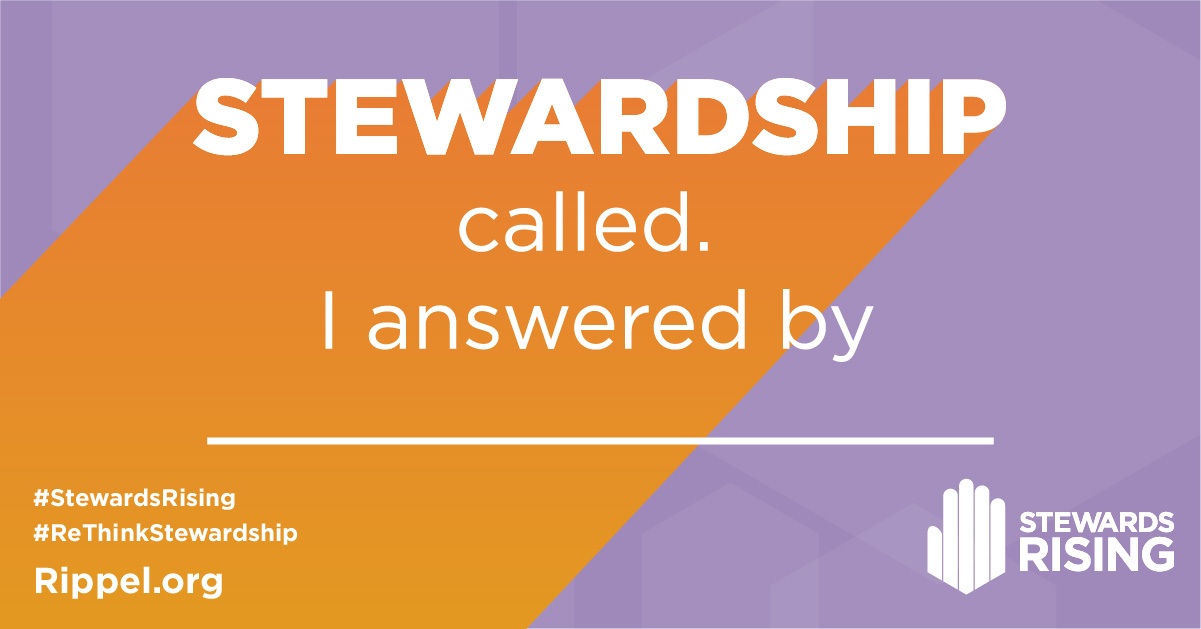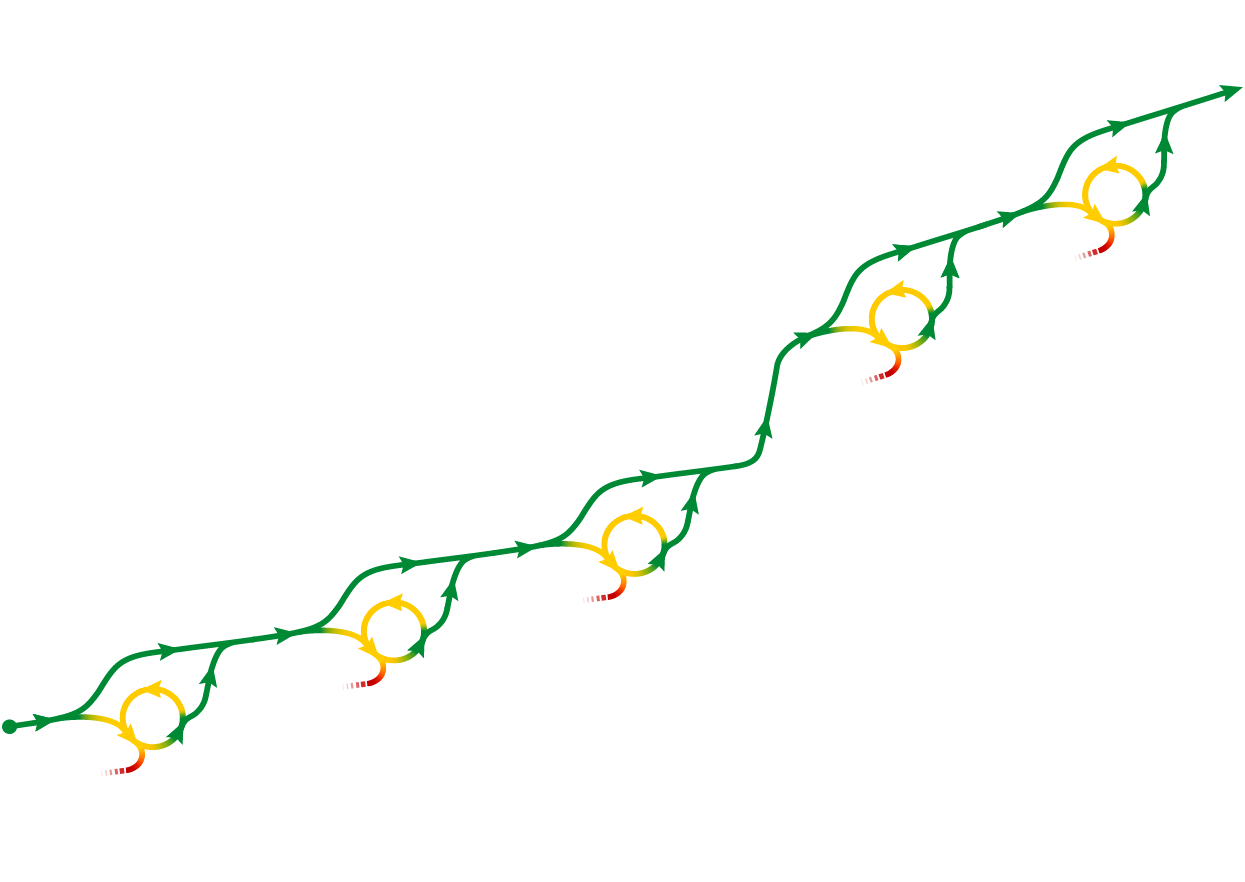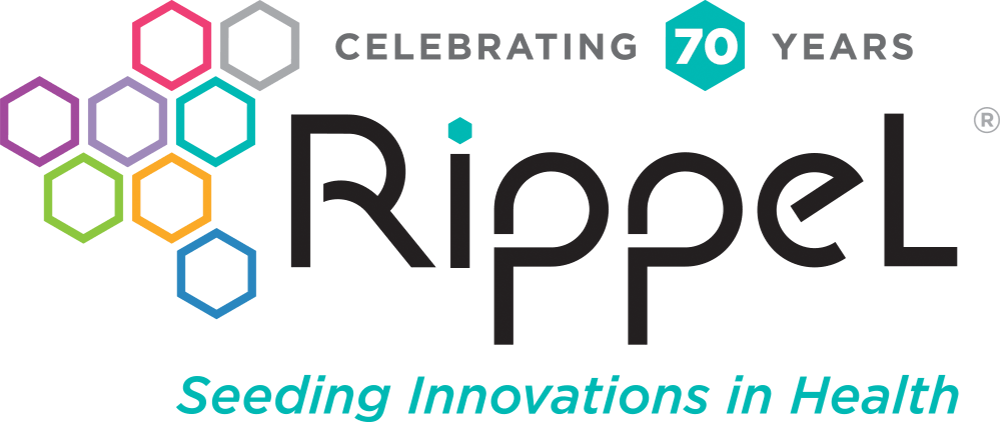Who Are Stewards?

Stewards are people or organizations who take responsibility for working with others to create conditions that all people need to thrive, beginning with those who are struggling and suffering. Stewards may be affiliated with organizations or may act on their own agency, such as a resident. Stewards have (or are interested in developing) an equity orientation in regard to purpose, power, and wealth.

They understand
- Purpose must be larger than oneself and one’s organization.
- Power must be built and distributed with others, not consolidated.
- Wealth must be invested, not withheld, to create long-term value as well as address short-term urgent needs.
As a Rippel initiative, we are interested in working with a particular kind of steward—those who are positioned to influence how regional decisions are made, and how resources are spent—to equitably shift the system in ways that better produce health and well-being.
How do stewards shift the system that produces health and well-being?
Rippel’s best hypothesis is that as stewards mature in their ability to facilitate cross-sector collaboration and alignment, they are able to create a new ecosystem for health and well-being in their regions; an ecosystem known for producing equitable outcomes. This hypothesis is backed by both empirical and anecdotal evidence. Like Rippel, you might be wondering: how do stewards mature? Working together with stewards to discover “how” is the reason for Rippel’s ReThink Health initiative and its multiple projects.
One of the major contributions of the ReThink Health Frontiers and Ventures projects was to develop A Pathway for Transforming Health and Well-Being Through Regional Stewardship. This Pathway clarifies Rippel’s hypothesis about the essential practices stewards should commit to and develop as part of their quest. It also describes what stewards can expect to experience when they work together in these ways, across five phases of development.
As our team works with stewards, we all get more and more knowledgeable about what the Pathway ought to include. With the passing of time we have refined our hypothesis, making it stronger and better for stewards who want to use it as a framework for transforming the regions they serve. Refinement will continue as we take on each new initiative and project.
Shared Stewardship in Health Care: Transformational Practices for Thriving Together
Leaders and change agents who want to have a transformative impact on the health and well-being of their communities will find pragmatic, innovative ideas in this guide.
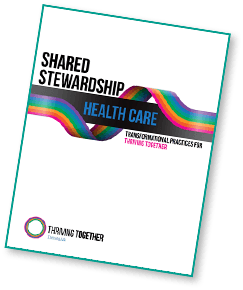
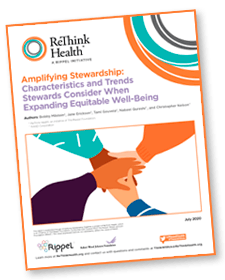
Amplifying Stewardship: Characteristics and Trends Stewards Consider When Expanding Equitable Well-Being
This report profiles characteristics of people who are not only impressive stewards, but also are helping to grow the entire field of system stewardship for well-being.
Dive into the Pathway and learn about
What happens when stewards work with Rippel’s ReThink Health team?
ReThink Health’s team works together with stewards as learning partners. As stewards mature, they conquer challenge after challenge, and then encounter new ones. Rippel works hard with stewards who are at the forefront of discovering what it takes to overcome these challenges, including:
- Regional cross-sector groups who are the furthest along on the Pathway. These groups often include regional philanthropists, policymakers, corporate, nonprofit, and resident leaders. For example, we worked with multisector partnerships in six regions on Ventures. We also worked with THRIVE, a coalition in central Michigan working to transform health and the economy in their region.
- Individual or cross-sector groups convening in state or nationwide networks to influence regional work. For example, we’ve partnered with the California Accountable Communities for Health Initiative (CACHI) to help networked leaders of regional multisector partnerships advance in their resident engagement and sustainable financing activities. We also work with the National Academies of Sciences, Engineering, and Medicine (NASEM) to shape the nation’s agenda for population health.
- Stewards who recognize the regional influence their organization has, and seek to have greater impact. These stewards often have major national influence on regional work, or who are anchor institutions with a vested interest in the region’s prosperity and are unlikely to leave the region. For example, we work with major hospital systems in a variety of regions on our Hospital Systems in Transition project, and that project is funded by the Robert Wood Johnson Foundation as part of their interest in learning how regional stewards can best transform health and well-being.
What is a region?
Regional stewards determine their geographic area of focus for their transformation effort, and there isn’t a standard way to do so. Stewards may draw a “regional area” boundary by neighborhood, zip code, county, city, hospital service area, hospital referral region, or other self-defined configurations.
We work with our steward partners to carefully consider the six conditions of systems change, and ask: what conditions are holding the problem in place and how can stewards shift them to produce better health and well-being for all? Then, we prototype, make sense of, and refine strategies that best help stewards move along the Pathway and nudge their systems forward. We share the most promising strategies widely, so many more stewards can benefit.
Shifting the Conditions That Hold the Problem in Place

Stewardship is an already-established practice
In 2000, the World Health Organization broadly defined stewardship as “the careful and responsible management of the well-being of the population”, and in the most general terms as “the very essence of good government.” [citation]Kapoor N, Kumar D, Nivedita Thakur N. Core attributes of stewardship; foundation of sound health system. Int J Health Policy Manag 2014; 3: 5–6. doi: 10.15171/ijhpm.2014.52https://www.ncbi.nlm.nih.gov/pmc/articles/PMC4075105/
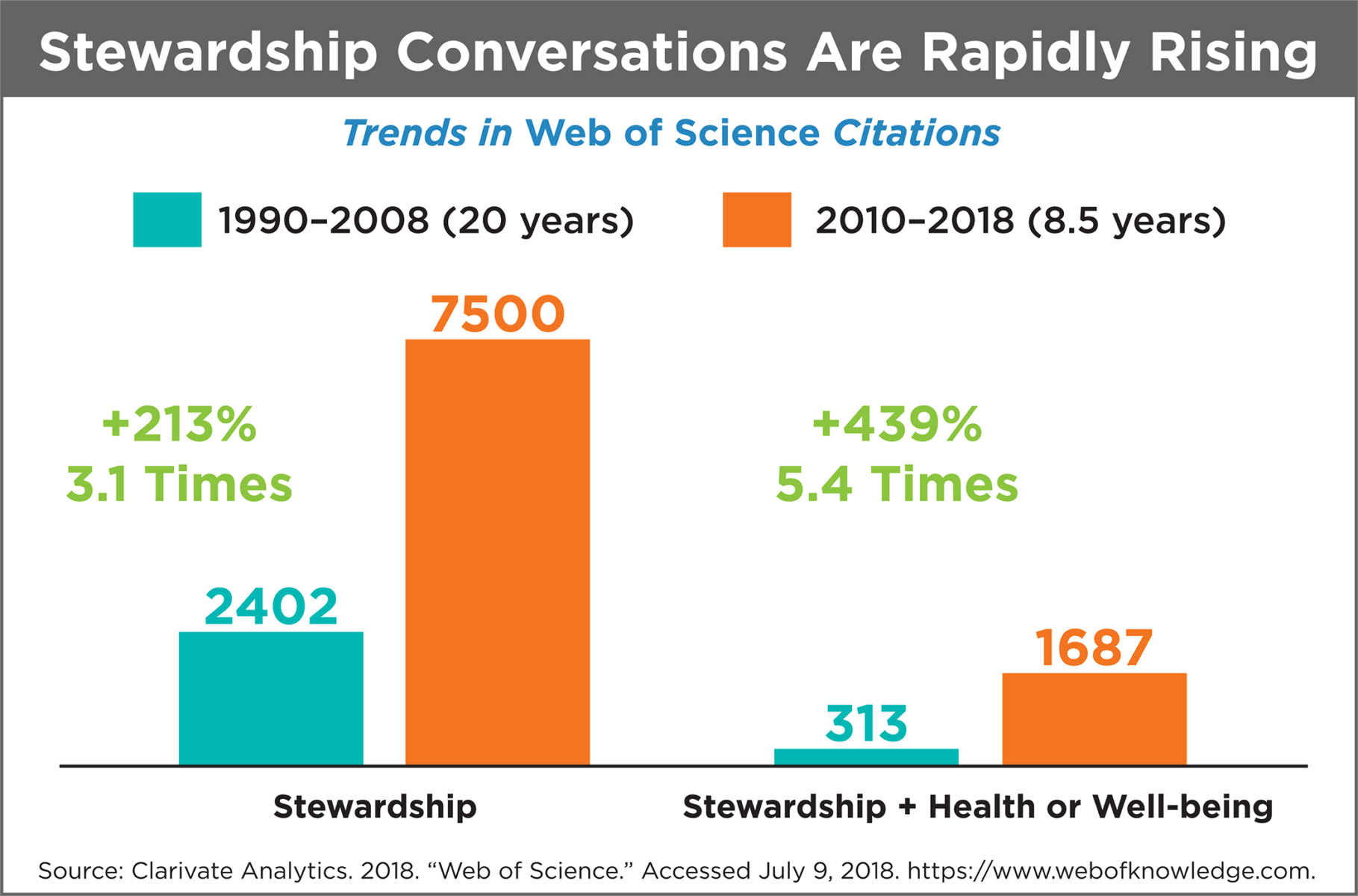
Highly respected leaders from around the world have also identified stewardship as a means to health and well-being. Here is a sample of their works:
Stewardship and Public Service: A Discussion Paper
From the Field
03/31/1997
This discussion paper prepared for the Public Service Commission of Canada presents stewardship as a bridge between purely market-based approaches and broader public sector responsibilities. While market-based reforms have shown many possible outcomes, they are not robust enough to embrace the full range of public sector activities, such as governance and guarding the public interest.
Health Stewardship: The Responsible Path to a Healthier Nation
From the Field
01/01/2009
The Aspen Institute published this paper explaining the value of health stewardship and making a case for its importance for successfully navigating the challenges facing the system that produces health and well-being.
What Help is a Steward? Stewardship, Political Theory, and Public Health Law and Ethics
From the Field
12/20/2011
As part of The Northern Ireland Legal Quarterly journal’s special issue on ‘super-stewardship’ and the related work of Roger Brownsword, this paper critically examines stewardship in public health.
Achieving Accountability for Health and Health Care Minneapolis, MN
From the Field
11/01/2012
This article in Minnesota Medicine proposes Accountable Health Communities (AHCs) as a way to establish health system stewardship. They would to review local data against the Triple Aim, create shared goals and investments, and involve citizens in reform and stewardship.
Stewardship: Choosing Service Over Self-Interest
From the Field
01/01/2013
In this book, Peter Block asserts that a fundamental shift in how we distribute power, privilege, and the control of money—away from self-interest and toward stewardship—can transform every part of an organization for the better, and he examines the nitty-gritty of implementing these reforms.
Core Attributes of Stewardship; Foundation of Sound Health System
From the Field
03/01/2014
This International Journal of Health Policy and Management Perspective offers one way to look at stewardship, positing that it has five core attributes: responsible management, political will, a “normative dimension” (equity), balanced interventions, and components of good governance.
Public Involvement and Health Research System Governance: a Qualitative Study
From the Field
08/30/2018
This article in Health Research Policy and Systems describes an exploratory, qualitative study of specific active stewardship efforts in two countries: England and Canada. It illustrates some of the benefits of stewardship while identifying three sets of common issues across both locations.
World Health Organization: Stewardship Resources
From the Field
01/01/2019
The World Health Organization has collected resources related to stewardship, with an emphasis on the health care sector.
Stewards Rising
Answering the Call for Change
Stewards are people or organizations who work in coordination with others to create the conditions that all people need to thrive. Shared stewardship is a lifelong journey that any individual or organization can embark upon.
Whether you are just beginning your stewardship journey or are already a champion of stewardship, we hope you find inspiration in these stories from stewards in diverse communities and sectors throughout the nation who are working across differences to achieve equitable health and well-being.
The Journey of Stewardship
Listen to the perspectives of those who answered the call.
Stories from Stewards
Discover the real-life successes and challenges of stewardship in action.
A Tale of Two Systems: Health and Wealth
Jerome Adams
Former US Surgeon General
Doing Business Differently to Address Mental Health
Abby Goodwin
Palm Health Foundation
Sowing Seeds to Plant Change in Detroit
Dave Spivey
Trinity Health
Closing Gaps in Community Health
Lisa Gentz
5 Healthy Towns Foundation
Seeking Insights to Strengthen Shared Stewardship
Anita Chandra
RAND Corporation
Making a Commitment to Health Equity
Erin Morton
P-CHE
Launching a Mental Health Collaborative
Shirley Holland & Dr. Bob Trestman
Carilion Clinic
Building a Network of Changemakers
Somava Saha
WIN Network
Imagine Fox Cities: Creating a Community Where Everyone Belongs
Stewards in Fox Cities, WI, are working to create an inclusive community where everyone can thrive. Find out how in this multimedia narrative.
The Stewardship Mindset
Hear from Lisa Gentz of Community Mental Health and 5 Healthy Towns in Michigan who illustrates how partnering with others in stewardship will increase thriving in communities.
Stewards at Every Level
Hear from Erin Morton of Thomas Jefferson University Hospitals who discusses the importance of leadership buy-in and effective goal setting to improve community health.
Combatting Inequity
Hear from Somava Saha of the WIN Network who underscores the necessity of addressing systemic inequities to ensure stewardship and its benefits are accessible to all people, in all places.
Reflect on Your Stewardship Journey
Share your story and inspire others.
Share your thoughts below!
#StewardsRising #ReThinkStewardship
Share your thoughts below!
#StewardsRising #ReThinkStewardship
Share your thoughts below!
#StewardsRising #ReThinkStewardship
Share your thoughts below!
#StewardsRising #ReThinkStewardship
Share your thoughts below!
#StewardsRising #ReThinkStewardship
For better viewing experience use a screen that is bigger than 1024 pixels wide
Stewards’ Pathway
Stewards embraced a funding approach based on distributed leadership. They shifted from a grantmaking process where board members made all funding decisions to a more strategic and shared approach that gives ownership and decision-making authority to its nine working groups, each with their own focus (e.g., behavioral health or cardiovascular disease).
Transforming the system that produces health and well-being is no small task. To do it well, regional stewards need to work together to intentionally take responsibility for facilitating the cross-sector collaboration and alignment that creates the conditions for lasting change. This Pathway describes what stewards (people or organizations) can expect when they work together to practice and develop their stewardship as part of their quest to create equitable opportunities for everyone to reach their potential for health and well-being.
|
PHASE 1
|
PHASE 2
|
PHASE 3
|
PHASE 4
|
PHASE 5
|
|
Coming
Together |
Exploring
Regional Goals |
Building an
Interdependent Portfolio |
Making the
Portfolio Happen |
Living the
New Ecosystem |
|
Stewards focus on issue-specific activities to solve an identified problem or need, typically for a limited period of time. Their work together is transactional, with each contributor doing their part without changing old routines or adjusting their understanding of self-interests. Application of system thinking: Level of collaboration: Level of inclusiveness: |
Stewards form wider and more routine working relationships. They begin to articulate a clear, compelling, and shared vision for producing equitable health and well-being in their region. They explore what it is like to share information and responsibility across multiple issues and initiatives, while still largely competing for resources to support their own part of the work. Application of system thinking: Level of collaboration: Level of inclusiveness: |
Stewards work together routinely to pursue a clear, compelling, and shared vision for the entire region, including all of its people. That vision also guides investments and actions. They negotiate and begin to enact an interdependent portfolio of interventions, with multiple elements that are designed synergistically to yield both short- and long-term benefits. Application of system thinking: Level of collaboration: Level of inclusiveness: |
In the most risky and rewarding phase of all, stewards abandon business as usual. They position their own work to align with a wider portfolio of interventions, which they have collectively designed to produce equitable health and well-being in the region. They act through new roles and new mindsets to bring their portfolio to life. Stewards commit themselves to new ways of doing business together. They embrace—and enforce—new norms because their vital interests now depend on it. Application of system thinking: Level of collaboration: Level of inclusiveness: |
New institutions, markets, and accountability mechanisms have emerged through new patterns of working relationships among stewards. In the new ecosystem, the interactions among an extensive collection of organizations are in sync producing fair and just opportunities for health and well-being. The means for continuous monitoring and improvement are integrated into new system design, including the means for a new wave of transformation should it be necessary. Certain groups formed in prior phases may have been a temporary means to reach the current state, and may be disbanded if no longer necessary. |
- Coming Together
-
 Transforming the System that Produces
Transforming the System that Produces
Regional Health and Well-Being
-
Living the
New Ecosystem
SHARED VISION
Regional stewards anchor their work in a SHARED VISION. Together, they create an image of what they want to build; a public declaration of the aspirations they hold in their heads and their hearts.
Regional stewards anchor their work in a SHARED VISION. Together, they create an image of what they want to build; a public declaration of the aspirations they hold in their heads and their hearts.
stewardship
Stewards work together across boundaries to create the conditions for equitable health and well-being. This involves efforts to negotiate shared values, establish and enforce norms, resolve conflict, and adapt to circumstances in a constantly changing world.
Stewards work together across boundaries to create the conditions for equitable health and well-being. This involves efforts to negotiate shared values, establish and enforce norms, resolve conflict, and adapt to circumstances in a constantly changing world.
strategy
Stewards navigate changing conditions to pursue an interdependent portfolio of interventions for the region that will best achieve equitable health and well-being.
Stewards navigate changing conditions to pursue an interdependent portfolio of interventions for the region that will best achieve equitable health and well-being.
FINANCING
Stewards develop a long-term financial plan and secure dedicated funds to accomplish the portfolio of interventions.
Stewards develop a long-term financial plan and secure dedicated funds to accomplish the portfolio of interventions.
Regional stewards anchor their work in a SHARED VISION. Together, they create an image of what they want to build; a public declaration of the aspirations they hold in their heads and their hearts.
| PHASE 1 | PHASE 2 | PHASE 3 | PHASE 4 | PHASE 5 |
|
Coming |
Exploring |
Building an |
Making the |
Living the |
| By working together, stewards articulate shared aspirations for their issue-specific efforts. | By working together in wider, more routine relationships, stewards begin to articulate a clear, compelling, and shared vision for producing equitable health and well-being in their region. Their work is based on strongly held values and a clear view of the costs of inaction. The vision recognizes both the complexity and challenge of creating lasting solutions. | Stewards work together routinely to pursue a clear, compelling, and shared vision for the entire region, that will benefit all of its people. That vision also guides investments and actions. | A critical mass of stewards commit to a shared vision for the region. They continuously reflect on outcomes and refine activities, to ensure the vision is being achieved. | The vision of a transformed system is now more fully realized, even though it’s still faced with old and new threats. The health ecosystem consists of interdependent institutions, markets, and accountability mechanisms that enable stewards to maintain equitable health and well-being in a constantly changing world. |
Practice
Stewards articulate and routinely pursue a clear, compelling, shared vision for the region.
Stewards work together across boundaries to create the conditions for equitable health and well-being. This involves efforts to negotiate shared values, establish and enforce norms, resolve conflict, and adapt to circumstances in a constantly changing world.
| PHASE 1 | PHASE 2 | PHASE 3 | PHASE 4 | PHASE 5 |
|
Coming |
Exploring |
Building an |
Making the |
Living the |
| Stewards focus on issue-specific activities to solve an identified problem or need for a limited period of time. Their work together is transactional. Governance activities are contractual or ad hoc to suit the purpose and the project time frame. | Stewards seek to heighten the region-wide legitimacy, influence, and interdependence of their work together. | Stewards figure out how to align their independent, status quo approaches to create a more interdependent region, and figure out what work they must do together to achieve their shared vision. Efforts to build an interdependent portfolio of interventions are widely viewed as legitimate. | Stewards develop and champion new governance roles and mindsets necessary to facilitate implementation of the portfolio of interventions. | Governance activities are a function of the new institutions, markets, and accountability mechanisms that have emerged. |
Practice
Ensure that stewards’ efforts, including governance and management activities, are aligned to achieve their shared vision.
Stewards work together across boundaries to create the conditions for equitable health and well-being. This involves efforts to negotiate shared values, establish and enforce norms, resolve conflict, and adapt to circumstances in a constantly changing world.
| PHASE 1 | PHASE 2 | PHASE 3 | PHASE 4 | PHASE 5 |
| Coming Together | Exploring Regional Goals | Building an Interdependent Portfolio | Making the Portfolio Happen | Living the New Ecosystem |
| Stewards devise temporary ways of working together by coordinating and managing their issue-specific efforts. Management activities are ad hoc to suit the purpose and the project time frame. | Stewards begin to develop structures and norms to handle the integrative activities necessary to manage the work they must do together. | Stewards work together through an effective network. They conduct integrative activities to manage and modify a shared portfolio of interventions so that it produces the system change they desire. Management needs (workflows between partnerships, liability protection, financial management, communications, data analysis, technologies, facilities, and more) can be handled by one or more organizations acting on behalf of all stewards. | Stewards become adept at the integrative activities that are necessary to effectively manage their shared efforts to implement the portfolio of interventions. | The appropriate management structures and norms are integrated into the new ecosystem. |
Practice
Ensure that stewards’ efforts, including governance and management activities, are aligned to achieve their shared vision.
Stewards work together across boundaries to create the conditions for equitable health and well-being. This involves efforts to negotiate shared values, establish and enforce norms, resolve conflict, and adapt to circumstances in a constantly changing world.
| PHASE 1 | PHASE 2 | PHASE 3 | PHASE 4 | PHASE 5 |
|
Coming |
Exploring |
Building an |
Making the |
Living the |
| The range of stewards working together is primarily limited to those well-established organizations with direct vested interest in the issue. Residents and other potential contributors are rarely seen as having legitimate agency. | Diversity of stewards in collaborative partnerships is expanding. Stewards increasingly reach out to others not yet involved to help assess options or make decisions. | Highly inclusive. More and more stewards feel that they belong and can contribute. They join the regional effort because they see it as a legitimate path to change, and they want their knowledge, expertise, and contributions to influence that process. | Stewards who are already part of the regional transformation effort fully understand and value the benefits of being involved and recognize that their goals cannot be accomplished without widespread inclusivity. They structure their work to enable the broadest possible participation from stewards not already in the mix. | The new ecosystem is highly inclusive. |
Practice
Stewards seek to expand the diversity and number of other stewards involved.
Stewards work together across boundaries to create the conditions for equitable health and well-being. This involves efforts to negotiate shared values, establish and enforce norms, resolve conflict, and adapt to circumstances in a constantly changing world.
| PHASE 1 | PHASE 2 | PHASE 3 | PHASE 4 | PHASE 5 |
|
Coming |
Exploring |
Building an |
Making the |
Living the |
| Stewards’ work together is transactional, with each contributor doing their part without really changing old routines or adjusting their understanding of self-interests. Contributions are mostly in-kind because the stewards participating on behalf of their organizations do not necessarily have the authority to commit resources. | Stewards explore what it is like to share information and responsibility for addressing multiple issues and initiatives, while still largely competing for resources to support their own part of the work. The scope of working relationships broadens to include those who have the authority to represent and act on behalf of their own organizations. | Stewards work collaboratively, developing a willingness to be transparent as well as an understanding about one another’s vested interests. Stewards also express the intention to be mindful about distribution of resources as well as surfacing and reconciling conflicts. The stewards participating on behalf of their organizations include senior leaders with the authority to commit some of their own organizations’ resources to pursue the shared, region-wide vision and goals. | Stewards are fully aware and respectful of one another’s vested interests as they engage in ongoing negotiation processes to align and advance their work. As a result, they enact new policies and financial incentives so organizational interests can be more in sync with regional interests. | The system is aligned so that organizational interests are in sync with regional interests, and there are well-established procedures to surface and resolve inevitable conflicts. |
Practice
Stewards increase their commitment to the regional effort, relative to their vested interests.
Stewards work together across boundaries to create the conditions for equitable health and well-being. This involves efforts to negotiate shared values, establish and enforce norms, resolve conflict, and adapt to circumstances in a constantly changing world.
| PHASE 1 | PHASE 2 | PHASE 3 | PHASE 4 | PHASE 5 |
|
Coming |
Exploring |
Building an |
Making the |
Living the |
| Stewards are focused on ensuring that broader groups of residents (those who live and work in the community but are not professionally involved in regional stewardship) are using and benefiting from the services or programs that are provided by participating organizations. | Stewards encourage organizations to consult broader groups of residents to hear their perspectives. Residents may participate on an ad hoc basis but rarely have leadership authority. | Stewards, both individually and together, begin to see the value of listening to the voices of broader groups of residents, and cultivating residents’ role as leaders. They begin to develop and establish processes for residents to inform organizational policies, practices, and investment priorities. Residents participate and give feedback or input, but rarely have leadership authority. | Stewards create the conditions for robust, routine, and transparent resident leadership. Organizations routinely incorporate practices of meaningful participation, feedback, input, and support for active resident leadership. Resident voices are integral to the design and decision-making processes used to produce health and well-being in the region. | Residents are active co-producers of health and well-being, continuously shaping new institutions, markets, and accountability mechanisms. |
Practice
Stewards create the conditions for robust, routine, and transparent resident leadership.
Stewards work together across boundaries to create the conditions for equitable health and well-being. This involves efforts to negotiate shared values, establish and enforce norms, resolve conflict, and adapt to circumstances in a constantly changing world.
| PHASE 1 | PHASE 2 | PHASE 3 | PHASE 4 | PHASE 5 |
|
Coming |
Exploring |
Building an |
Making the |
Living the |
| Stewards who are working together measure and share knowledge about the activities and achievements of their issue-specific efforts. | Stewards begin to adopt common measures for their combined efforts and share data and knowledge related to these efforts to track and improve outcomes. | Stewards have clearly defined expected outcomes and impacts for the work they do individually and together. They use common measures that are aligned with their shared purpose. They have set up integrated structures and processes for sharing data, ensuring data is widely understood, and ongoing learning. | Stewards have structured systems and processes to integrate data and chart progress across the region and regularly engage in reflective practices to assess progress. | Region-wide measures are used to assess equitable health and well-being over the long term. Integrated data and learning systems are used for continuous adaptation to assure ongoing alignment with the shared vision. |
Practice
Stewards use common measures and integrate data. They share knowledge and use it to reflect on and refine their practice.
Stewards navigate changing conditions to pursue an interdependent portfolio of interventions for the region that will best achieve equitable health and well-being.
| PHASE 1 | PHASE 2 | PHASE 3 | PHASE 4 | PHASE 5 |
|
Coming |
Exploring |
Building an |
Making the |
Living the |
| There is rarely a well-articulated theory of system change. Stewards often act on the belief that their specific, often singular interventions will yield systemic change for the region. They are not typically aware of interdependencies, tradeoffs, and unintended effects of their efforts on others. | Stewards realize that siloed, issue-specific initiatives are insufficient to achieve lasting change in health and well-being. Stewards are aware of the potential to use systems thinking to achieve their common purpose, but they are applying it only on a limited basis. | Stewards develop a theory of system change—meaning they acknowledge that the many forces that produce equitable health and well-being in a region work together as a system, and they seek to understand how the system tends to change or resist change over time. They enact the theory through the portfolio of interventions. | Stewards embrace a sound theory of system change to pursue their vision for equitable health and well-being in the region. They rely on and continually refine this shared theory as they learn from ongoing experience, incorporate new research, identify areas of leverage, anticipate pitfalls, and weigh tradeoffs in a constantly changing world. | Stewards rely on and continually refine their theory of system change to keep up with new insights and emerging challenges. |
Stewards navigate changing conditions to pursue an interdependent portfolio of interventions for the region that will best achieve equitable health and well-being.
| PHASE 1 | PHASE 2 | PHASE 3 | PHASE 4 | PHASE 5 |
|
Coming |
Exploring |
Building an |
Making the |
Living the |
| Stewards focus primarily on singular, independent interventions designed to address an identified need or problem. | Stewards recognize that a disconnected set of programs, projects, and policies will not harness the full potential for health and well-being in the region, and they begin to explore the value of designing a cohesive, interdependent portfolio of interventions. | Stewards design an interdependent portfolio of interventions to produce equitable health and well-being in the region. It includes a balanced and impactful set of policies, programs, and practices that are intended to work together and yield both short- and long-term benefits. Their portfolio balances services for urgent needs (such as acute care for illness/injury, or food assistance) with investments to assure the vital conditions that everyone depends on to reach their full potential (such as humane housing, living wage, education, routine care, and others). | Stewards enact an interdependent portfolio of interventions and begin to see system change in the region. The portfolio balances policies, programs, and practices related to urgent needs (such as acute care for illness/injury, or food assistance) with those intended to assure the vital conditions that everyone depends on to reach their full potential (such as humane housing, living wage, education, routine care, and others). | An interdependent portfolio of interventions in the region has created a balanced and impactful set of policies, programs, and practices (including new investment priorities and spending patterns) that produce equitable health and well-being. |
Practice
Stewards design an interdependent portfolio of interventions.
Stewards develop a long-term financial plan and secure dedicated funds to accomplish the portfolio of interventions.
| PHASE 1 | PHASE 2 | PHASE 3 | PHASE 4 | PHASE 5 |
|
Coming |
Exploring |
Building an |
Making the |
Living the |
| Stewards have budgets for their short-term, issue-specific efforts. Resources other than in-kind labor rarely combine across organizational lines. | Most stewards do not have a long-term financial plan in place, but they are moving toward multi-year budgets for their issue-specific efforts. Integrative activities may be funded by grants or in-kind support, but there is rarely specific outside funding or a plan for long-term sustainability. |
Stewards develop a long-term financial plan for implementing their portfolio of interventions. The plan:
|
Stewards refine and execute a 15-25 year financial plan for enacting their portfolio of interventions, including for integrative activities. The plan includes:
|
New financing structures, such as budget processes, payment models, pooled resources, financial incentives, and business models, support the priorities for equitable health and well-being. |
Practice
Stewards develop a long-term financial plan for implementing the portfolio of interventions and related integrative activities.
Stewards develop a long-term financial plan and secure dedicated funds to accomplish the portfolio of interventions.
| PHASE 1 | PHASE 2 | PHASE 3 | PHASE 4 | PHASE 5 |
|
Coming |
Exploring |
Building an |
Making the |
Living the |
| Most stewards do not have sustainable financing. Funding is limited to short-term sources, most often ad hoc and/or one-time contributions, grants, and in-kind gifts to support their issue-specific efforts. | Most stewards do not have sustainable financing for their work. Funding is limited to short-term sources, most often ad hoc and/or one-time contributions, grants, and in-kind gifts. Stewards may begin to commit their organizational resources to strengthen working relationships with each other. | Stewards are exploring and beginning to access diverse, long-term funding sources that will be needed to implement the portfolio of interventions and related integrative activities. This may include the sources for a pooled fund, such as a wellness trust. Some stewards are beginning to shift their organizational resource allocations in concert with the portfolio of interventions. | Long-term, dedicated funds have been secured to accomplish the portfolio of interventions because regional stewards have shifted their organizational resource allocations. | There are sufficient, diverse, and dependable financial resources devoted to produce equitable health and well-being in the region. |
Stewards’ Terms
- Diversity
- Equitable Health and Well-Being
- Health Ecosystem
- Integrative Activities
- Governance Activities
- Management Activities
- Interdependent Portfolio of Intervention
- Region
- Residents
- Stewards
- Stewardship
- System Thinking
- Theory of System Change
- Vital Conditions
- Working Relationships
- Urgent Services
Diversity
The collective mix of differences and similarities among stewards’ individual and organizational characteristics, values, beliefs, experiences, backgrounds, and behaviors. It encompasses personal and professional histories that frame how stewards see the world and interact with each other. It also encompasses many simultaneous dimensions of human difference including age, sex, color, class, education, sexual orientation, nativity, language, and more.
Equitable Health and Well-Being
Often shortened to “health and well-being,” or simply “health,” this denotes the overall level and distribution of healthiness and quality of life for all people in a given region, including the presence of fair and just opportunities for everyone to reach their full potential. It is not limited only to the healing or strengthening of the body against injury and disease, but instead includes all aspects of health and well-being, including physical and psychological health, security, economic prosperity, connectedness, and more.
Health Ecosystem
A system composed of an extensive collection of distinct variables and organizations that depend on and interact with one another to produce health and well-being in a region.
Integrative Activities
Stewardship roles and leadership functions for governing and managing stewards’ working relationships to achieve a common purpose.
Governance
Integrative governance activities hold the balance between stewards’ individual and collective goals, to contribute to the prosperity and viability of the region as well as stewards’ working relationships. Governance activities ensure accountability, transparency, and fairness across stewards.
Management
Among other things, management activities coordinate establishment of basic infrastructure to support stewards’ working relationships, including establishment of workflow structures, equipment, technologies, facilities, and services.
Interdependent Portfolio of Intervention
A balanced and impactful set of policies, programs, and practices that stewards implement to produce equitable health and well-being in their region.
Region
Regional stewards determine their geographic area of focus for their transformation effort, and there isn’t a standard way to do so. Stewards may draw a “regional area” boundary by neighborhood, zip code, county, city, hospital service area, hospital referral region, or other self-defined configurations.
Residents
People who live and work in the community who are not professionally involved in regional stewardship, regardless of citizenship or immigration status.
Stewards
Stewards are people or organizations who take responsibility for working with others to create conditions that all people need to thrive, beginning with those who are struggling and suffering. Stewards may be affiliated with organizations or may act on their own agency, such as a resident. Stewards have (or are interested in developing) an equity orientation in regard to purpose, power, and wealth.
Stewardship
The act of stewards working together across boundaries to create the conditions for equitable health and well-being. This involves efforts to negotiate shared values, establish and enforce norms, resolve conflict, and adapt to circumstances in a constantly changing world.
System Thinking
A holistic approach to analysis and problem solving that focuses on the big picture to see how parts of a system connect as well as how our mindsets and actions shape consequences over time.
Theory of System Change
A comprehensive description of how and why a desired change is expected to happen. A theory of system change articulates the key trends that stakeholders can shift [via policies, programs, or practices (e.g., allocation of resources)] in order to transform the system’s performance over time.
Vital Conditions
Properties of places and institutions that all people depend on to be healthy and well. They include basic needs for health and safety, lifelong learning, meaningful work and wealth, humane housing, a stable natural environment, reliable transportation, as well as belonging and civic muscle (i.e., special capacities of people and institutions that convey to all a sense of belonging and power to influence the policies, practices, and programs that shape our world). These not only have the potential to enhance health and well-being, but also prevent harm and avert the need for costly, often inequitable urgent services.
Working Relationships
The routine pattern of connections among two or more stewards (people or organizations) intended to achieve a common purpose related to health and well-being.
Urgent Services
Services that anyone under adversity may need temporarily to regain or restore health and well-being. They include acute care for illness or injury, addiction treatment and recovery, criminal justice and emergency response, homeless services, environmental clean-up, as well as unemployment and food assistance.

14 Maple Avenue Suite 200, Morristown, NJ 07960, USA
678 Massachusetts Ave, Suite 400, Cambridge, MA 02139, USA
Phone: 973.540.0101
Email: [email protected]

